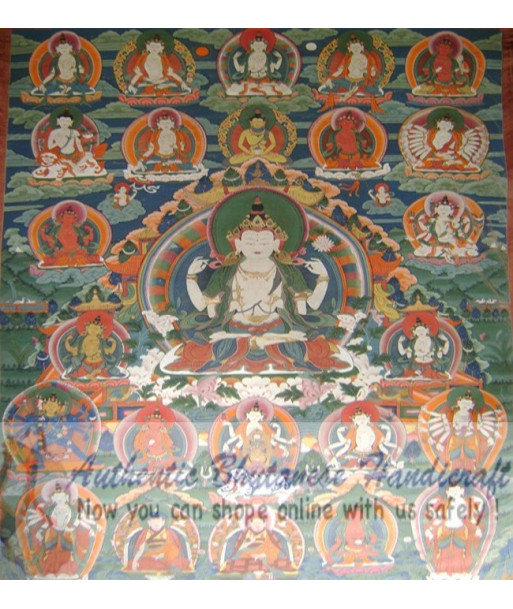- -50%






A **Chenrezig (Avalokiteshvara) Thanka** painting features Chenrezig, also known as Avalokiteshvara in Sanskrit, a revered bodhisattva in Tibetan Buddhism who embodies the compassion of all Buddhas. Chenrezig is celebrated for his boundless compassion and his ability to alleviate suffering.
 Security policy
Security policy
(edit with the Customer Reassurance module)
 Delivery policy
Delivery policy
(edit with the Customer Reassurance module)
 Return policy
Return policy
(edit with the Customer Reassurance module)
A **Chenrezig (Avalokiteshvara) Thanka** painting features Chenrezig, also known as Avalokiteshvara in Sanskrit, a revered bodhisattva in Tibetan Buddhism who embodies the compassion of all Buddhas. Chenrezig is celebrated for his boundless compassion and his ability to alleviate suffering.
### Key Elements of Chenrezig Thanka Painting:
1. **Central Figure**:
- **Chenrezig (Avalokiteshvara)**: The central figure in the thanka is Chenrezig, often depicted with specific attributes and qualities:
- **Appearance**: Chenrezig is usually shown with a serene and compassionate expression. His complexion can vary but is often depicted as white, symbolizing purity and the universal nature of his compassion.
- **Posture**: Chenrezig is often depicted seated in a meditative posture or standing, typically on a lotus flower or a throne, indicating his enlightened and compassionate nature.
2. **Attributes**:
- **Thousand Arms**: In some depictions, Chenrezig has a thousand arms, each holding different symbolic objects or making various gestures. This imagery represents his ability to reach out and help all sentient beings in countless ways.
- **Eye on the Palm**: In some representations, each hand has an eye, symbolizing his all-seeing compassion and his awareness of the suffering of sentient beings.
- **Lotus Flower**: Chenrezig is often depicted holding a lotus flower, which represents purity and spiritual blossoming.
3. **Iconography**:
- **Mantra**: Chenrezig may be shown holding a mala (prayer beads) or a lotus, often with the mantra "Om Mani Padme Hum" inscribed or associated with him. This mantra is central to his practice and symbolizes his ability to transform the suffering of beings into compassion and enlightenment.
- **Radiant Aura**: A halo or radiant light often surrounds Chenrezig, signifying his divine and compassionate nature. The light represents the illumination that his compassion brings to the world.
4. **Background and Surroundings**:
- **Sacred Landscapes**: The background of the thanka often includes serene and auspicious landscapes such as heavenly realms, lush gardens, or sacred mountains, reflecting the pure and compassionate nature of Chenrezig’s presence.
- **Auspicious Symbols**: Additional symbols like the Eight Auspicious Signs (Ashtamangala) might be present in the background, emphasizing the blessings and protection associated with Chenrezig.
5. **Mantras and Texts**:
- **Inscriptions**: Tibetan script or mantras related to Chenrezig's practice, such as "Om Mani Padme Hum," may be included around or within the painting. These texts are used to invoke Chenrezig’s blessings and to deepen the practitioner’s connection with his compassionate energy.
### Significance:
- **Embodiment of Compassion**: Chenrezig represents the boundless compassion of all Buddhas. The thanka serves as a focal point for meditation and devotion, helping practitioners to connect with and cultivate compassion in their own lives.
- **Meditation and Practice**: The Chenrezig Thanka is used in various meditation practices and rituals to invoke his blessings and to help practitioners develop a compassionate heart. Visualizing Chenrezig during meditation helps in opening oneself to greater empathy and understanding.
- **Symbol of Universal Compassion**: The painting symbolizes the ideal of universal compassion and the aspiration to alleviate the suffering of all sentient beings. It serves as a reminder of the importance of compassion and selflessness on the path to enlightenment.
The Chenrezig Thanka painting is a profound spiritual object that embodies the deep compassion and wisdom of Avalokiteshvara, offering inspiration and guidance for practitioners seeking to cultivate these qualities in their own spiritual journey.